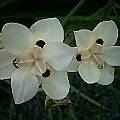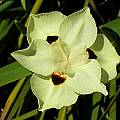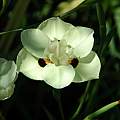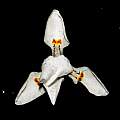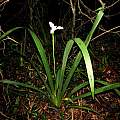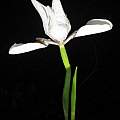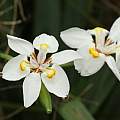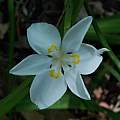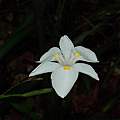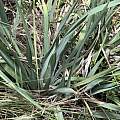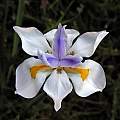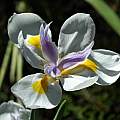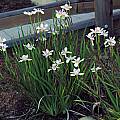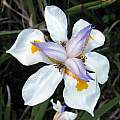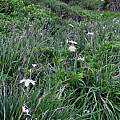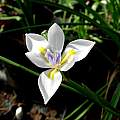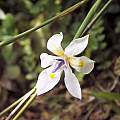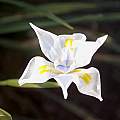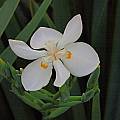Dietes is a small rhizomatous genus in the Iridaceae family with currently 6 accepted species. Most of the species are from tropical and South Africa, but there is one that originates on Lord Howe Island. These evergreen plants have long, sword-shaped leaves and white or yellow flowers with three large outer segments. The flowers are similar to Moraea and Iris. South African species are drought tolerant but will produce luxuriant plants with good watering. Because of this property they are often used in city landscaping.
Growing from seed is easy. Sow the seeds in a well drained mix, cover slightly, water, and keep them above 10 °C (50 °F). Treat the seedlings as you would any other irids (Andrew Wilson). They probably respond well to water and fertilizers.
Dietes bicolor (Steud.) Sweet ex Klatt is an evergreen species growing from 60 to 80 cm from a creeping rhizome. It is found on streambanks, often among rocks, in light shade in the Eastern Cape, South Africa. It is a very rewarding species, with a long flowering season, from late April to October in the Northern hemisphere (October to December in habitat). Better in half shade in a Mediterranean climate, it grows to a large clump with time. Flower stalks are perennial and should never be cut, as they make new flowers year after year. The first two photos by Angelo Porcelli and Alan Horstmann. The last photo by Mary Sue Ittner is of a plant flowering January 2010 in the Kirstenbosch National Botanical Garden.
Dietes butcheriana Gerstner, known as the Forest Iris, grows from .5 to 1.2 m in deep shade in mistbelt forest from the Southeastern Cape to KwaZulu-Natal. It is an evergreen, clump-forming perennial with a rhizomatous rootstock and broad, sword-shaped, leathery, erect dark green leaves arranged in an attractive fan-shape. It has large white, flat, spreading flowers that are spotted orange on yellow and flowers September-December. The flowers are very short lived, opening in the late afternoon and fading early evening. The fruit is a large roundish smooth shiny capsule. Photos from iNaturalist taken by Ricky Taylor at the Umlalazi Nature Reserve in September and by Sharon Louw at the Harold Johnson Nature Reserve in November and shared under a CC BY-NC license.
Dietes flavida Oberm., known as the Fan Woodiris is an evergreen rhizomatous perennial native to KwaZulu-Natal and the Northern Provinces of South Africa and to Swaziland where it grows in rocky areas and thicket. The grey-green leaves are in a fan. It has pale yellow to cream flowers with darker yellow to orange-brown markings and flowers September-January. Height range: 50-70 cm. Flowers are short lived, opening late afternoon, earlier on overcast days. The fruit is a hanging, oval capsule. Flower photos from iNaturalist taken by gerhardmalan in November in Mpumalanga and photos of leaves by Troos van der Merwe shared under a CC BY-NC license.
Dietes grandiflora N.E.Br. is an evergreen perennial with a creeping rhizome and sword shaped leaves. It is a popular garden plant with white flowers with a yellow median mark in the lower half and violet style branches. Unlike D. iridioides which has fleeting flowers, each flower lasts several days. Height: to 1.5 m. It is found on forest margins, in bush or rock outcrops, in the Eastern Cape. Photos by Mary Sue Ittner of the flower and a clump growing in a commercial area that blooms much of the year. The last two photos taken at the Kei River Mouth in the Eastern Cape by Cameron McMaster.
Dietes iridioides (L.) Sweet ex Klatt is an evergreen perennial usually found in bush clearings or evergreen forests from the southern Cape of South Africa to Ethiopia. It has white flowers that last a single day with inner petals marked with orange to brown streaks and the style branches lightly flushed with violet. Height: to 60 cm tall. Photo by Cameron McMaster taken in the Eastern Cape.
Dietes robinsoniana (F.Muell.) Klatt is a species from Lord Howe Island, an island off Australia. It has white fragrant flowers to 4 in in diameter with an orange nectar guide. Plants grow to 1.5 m high. Photo by Mary Sue Ittner of a flower blooming September 2007 in the Royal Botanic Gardens in Sydney.
